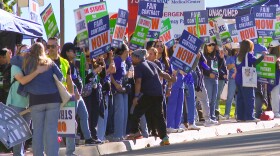Abdirashid Ali parked his yellow taxi outside a San Diego Starbucks, a favorite stop for Somali cab drivers like him taking a break between rides.
Ali has been doing this for six years; that is a long time for this high turnover industry. And that has made him into somewhat of a godfather figure for younger drivers, because he is always encouraging them to speak out about working conditions, high taxi lease fees, and lately, about job safety.
“He was my best friend," said Ali, referring to Mir Sadat Sahou. "If we had some safety, he should be here, today.”
Ali’s friend, Sahou, was shot to death last September as he dropped off a customer late one night. Sahou was a prominent figure back in Afghanistan, a former bank executive and television personality who started driving a cab after arriving as a refugee 20 years ago.
Sahou’s family believe his killing may have been politically motivated. But to most of his colleagues, his slaying - and a second one that occurred just four weeks later - point to the urgent need for better safety measures.
"We should have a camera, we should have safety," Ali said. "If somebody jumps into my car and he carries a gun, how can they find that person?”
In the last two decades, at least 700 taxicab drivers were killed on the job nationwide, according to the federal government. A 1970 occupational safety law requires employers to provide a "safe working environment" for cabbies, among other workers. But there are no enforced guidelines for what is a safe cab. Companies are often reluctant to spend the money to put in safety equipment, (such as partitions, or surveillance cameras, or emergency alert buttons) unless they are forced to.
In San Diego, the issue was recently taken up by a group of mostly immigrant taxi drivers, many of which are from Somalia, with some from Ethiopia and Eritrea.
"We are just a new organization that has no precedent in San Diego," said Mikaiil Hussein, president of United Taxi Workers of San Diego, which is only two-years-old.
“Our hands are tied in so many ways as cab drivers in this city," Hussein said. "But we are definitely going to get everything straightened.”
In San Diego, cab drivers typically do not own the taxis they drive. They lease them from middlemen owners, who in turn pay companies like Yellow Radio Service or San Diego Cab for the right to use their name. These days, it can cost a driver around $60 a day to lease a taxi. Add that to the cost of gas, and it can easily add up to $100 of daily expenses.
The recession has hit cabbies here hard: They are less likely to get long, expensive rides, and more people are taking public transportation. Besides, the demand for taxis in San Diego is nowhere near as strong as it is in a city like New York, where a cab driver can take home more than $50,000 a year, versus $30,000 in San Diego.
A 26-year-old Somali cab driver, who did not give his name for fear of facing reprisal from his lease company, said he barely makes enough to cover his rent.
“If I talk to the guys who used to work for a long time, they tell me that they used to get fares for like $100 or more," he said, waiting for his next fare downtown. "So it’s a little bit tougher now.”
He used to make a better living driving trucks, and as soon as the economy improves, he plans to leave his taxi for a truck. In the meantime, safety measures could come in handy, he said.
"I think that will be a good thing, because most of the time cameras could catch the person," he said. "I think sometimes when we are driving out here at night and you think you see a suspicious person, you don’t even want to take them. So you probably just avoid it and say, 'I’m not taking anybody right now.'”
On that front at least, the city’s cab drivers may get their wish: Owners of San Diego taxicabs are talking about installing new camera equipment inside cabs. But they would have to foot the bill for the costly security cameras. Those middlemen - like Eritrean or Axum Cab - refused to speak on the record for this story.







